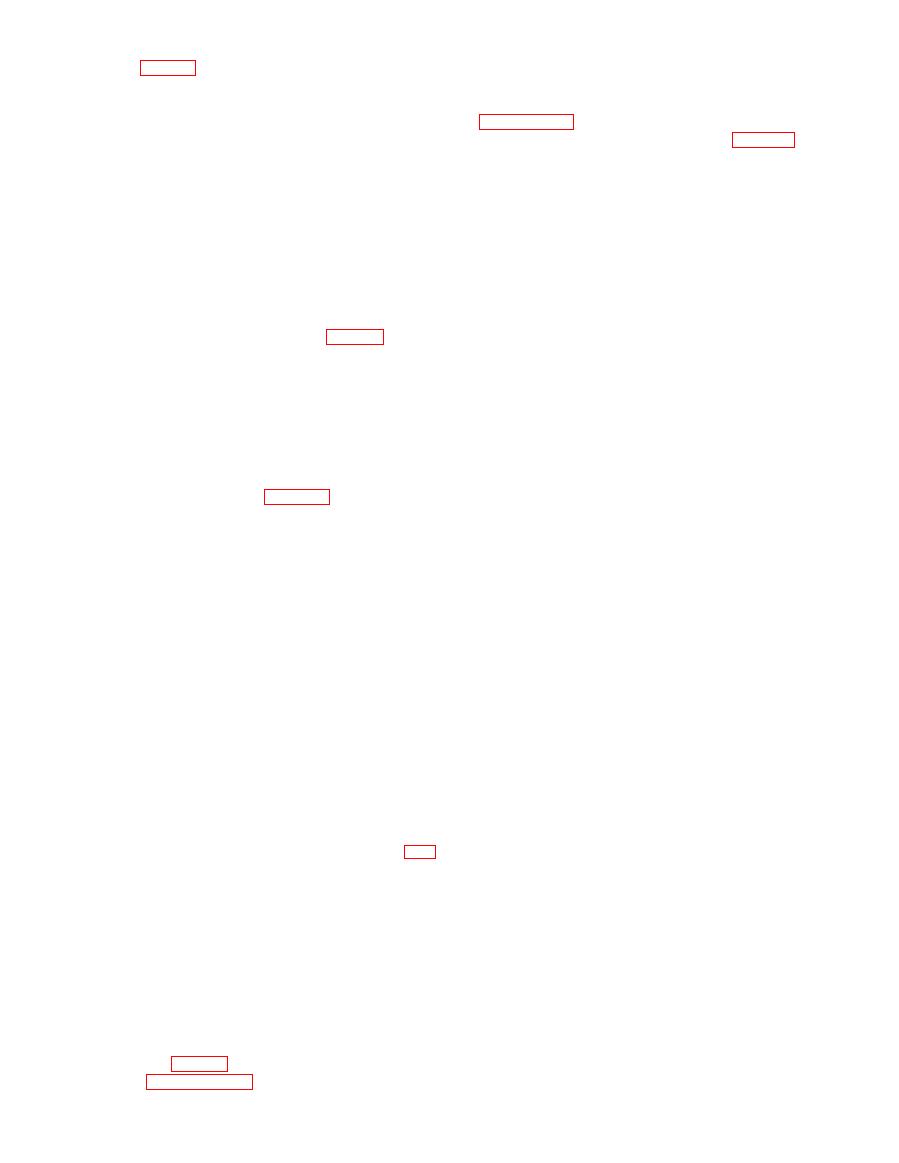 |
|||
|
|
|||
|
|
|||
| ||||||||||
|
|
 KEY to fig. 3-10:
a. Removal.
12. Valve inspection cover
1. Cap screw
(1) Remove the cylinder head as directed in
13. Gasket
2.Flat washer
14. Rotators
3. Cylinder head
(2) Remove the screws (10, fig. 3-10) and
15. Lock
4. Gasket
washers (11) securing the valve tappet inspection cov-
16. Valve spring seat
5. Nut
ers (12); remove inspection cover and gasket (13).
11. Valve spring
6. Lock washer
(3) Using a standard type valve spring lifter,
7. Lock washer
18.Valve
19. Valve tappet
compress the valve spring (17), remove the valve rota-
8. Cylinder block
20. Valve seat insert
tor (14) and valve spring seat retaining locks (15).
9. Gasket
21. Valve guide
After you release the valve lifter, remove the spring
10. Screw
11. Flat washer
seat (16) and valve spring (17), and lift the valve (18)
from the top of the cylinder block. As the valves are
removed, tag them or place them in order in a rack to
(3) Remove the cylinder block (8) and gasket
insure that you will reassemble each in the same valve
(9).
guide from which is was removed.
(4) Do not remove studs (28, fig. 3-13) unless
(4) Do not remove the valve guides (21) or
inspection indicates damaged threads, or bent or oth-
valve seat inserts (20) unless inspection indicates that
erwise damaged studs.
they are faulty.
b. Cleaning and Inspection.
(5) Lift the valve tappets (19) from the engine
(1) Clean the top of the cylinder block with a
block.
scraper and cloth dampened in cleaning solvent (fed.
(6) Remove the remaining valves.
spec. P-D-680). Clean all dirt and deposits from the
b. Cleaning, Inspection, and Repair.
cooling fins with a scraper or putty knife. You will be
(1) Discard and replace all gaskets.
able to perform a more thorough cleaning when the
(2) Clean the valves, valve springs, spring
valves have been removed (para 3-17).
seats, spring seat retaining locks, and valve rotators
(2) Clean all other parts with cleaning solvent;
with cleaning solvent (fed. spec. P-D-680); dry thor-
dry thoroughly.
oughly. Remove carbon deposits with wire brush.
(3) Inspect the cylinder block for cracks,
(3) Clean the valve guides installed in the
scored or scratched cylinder walls, or other defects.
block with a valve guide cleaner or wire brush.
(4) Check piston tit in the cylinder bores (para
Remove all lacquer and other deposits.
3-15 c ).
(4) Clean the valve seats with a wire brush.
(5) Check cylinder bore wear with an inside
(5) Check valve seat inserts for cracks or loose
micrometer. Measure the cylinder bore at 450 inter-
mounting. Replace faulty valve seat inserts.
vals below the travel of the lowest piston ring where
(6) Inspect the valves for deep pitting, cracks,
the cylinder is not worn. Compare this measurement
with a measurement taken about 1/4 inch below the
bent stems, distortion, and wear. If the valve faces are
not seriously damaged or marred, you can regrind
top of the cylinder. The maximum allowable cylinder
them. The valve face shall be ground at 45 to the
wear (the difference between these two measure-
vertical center line of the valve stem. The valve seat
ments) is 0.005 inch.
insert shall also be ground at a 45 angle. After grind-
(6) Replace the block if it is cracked, or if
ing, clean the valve and valve seat insert. Apply a
defects cannot be repaired. If proper piston fit (para
suitable lapping compound to the valve face and place
3-15 c) cannot be attained, the cylinders are scratched
the valve back into its proper guide. Using a recipro-
or scored, or cylinder wear exceeds 0.005 inch, rebore
cating advancing tool, lap each valve by rotating it
the cylinders as directed in subparagraph c below.
(7) Replace the cylinder block gaskets (9, fig.
back and forth. Occasionally, you should lift the valve
and reseat it in a different position to insure a uniform
3-l0).
seat. After valves have been lapped in evenly, remove
c. Reboring. Rebore the cylinders to 3.4575 to
them from the block and clean them with cleaning
3.4595 inch diameter (0.020 inch oversize). If this is
solvent.
not sufficient to eliminate cylinder wear or damage,
(7) Check for loose or worn valve guides.
rebore the cylinders to 3.4775 to 3.4795 inch diame-
Using a dial indicator, check the side movement of
ter (0.040 inch oversize). Maximum allowable over-
valve stem in guide. The valve stems shall have a new
bore is 0.040 inch.
clearance in the guides of 0.0025 to 0.0045 inch. When
d. Installation. Using new gaskets, install the
cylinder blocks in reverse order of removal. Install
the clearance becomes 0.008 inch, the guides must be
replaced. If you need to replace the guides, press them
each block on the same side of the crankcase from
which it was removed. Tighten cylinder block mount-
out with a driver that is slightly smaller than the exter-
nal diameter of the guide. Use the driver to press in the
ing nuts (5, fig. 3-10) to 62 to 78 foot-pounds torque.
new valve guides.
Refer to paragraph 3-17 c for tappet adjustment.
|
|
Privacy Statement - Press Release - Copyright Information. - Contact Us |